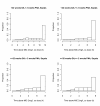Meropenem vs standard of care for treatment of late onset sepsis in children of less than 90 days of age: study protocol for a randomised controlled trial
- PMID: 21958494
- PMCID: PMC3193806
- DOI: 10.1186/1745-6215-12-215
Meropenem vs standard of care for treatment of late onset sepsis in children of less than 90 days of age: study protocol for a randomised controlled trial
Abstract
Background: Late onset neonatal sepsis (LOS) with the mortality of 17 to 27% is still a serious disease. Meropenem is an antibiotic with wide antibacterial coverage. The advantage of it over standard of care could be its wider antibacterial coverage and thus the use of mono-instead of combination therapy.
Methods: NeoMero-1, an open label, randomised, comparator controlled, superiority trial aims to compare the efficacy of meropenem with a predefined standard of care (ampicillin + gentamicin or cefotaxime + gentamicin) in the treatment of LOS in neonates and infants aged less than 90 days admitted to a neonatal intensive care unit.A total of 550 subjects will be recruited following a 1:1 randomisation scheme. The trial includes patients with culture confirmed (at least one positive culture from normally sterile site except coagulase negative staphylococci in addition to one clinical or laboratory criterion) or clinical sepsis (at least two laboratory and two clinical criteria suggestive of LOS in subjects with postmenstrual age < 44 weeks or fulfilment of criteria established by the International Pediatric Sepsis Consensus Conference in subjects with postmenstrual age ≥ 44 weeks). Meropenem will be given at a dose of 20 mg/kg q12h or q8h depending on the gestational- and postnatal age. Comparator agents are administered as indicated in British National Formulary for Children. The primary endpoint measured at the test of cure visit (2 days after end of study therapy) is graded to success (all baseline symptoms and laboratory parameters are resolved or improved with no need to continue antibiotics and the baseline microorganisms are eradicated and no new microorganisms are identified and the patient has received allocated treatment for 11 ± 3 days with no modification) or a failure (all remaining cases). Secondary outcome measures include comparison of survival, relapse rates or new infections by Day 28, clinical response at Day 3 and end of therapy, duration of hospitalisation, population pharmacokinetic analysis of meropenem and effect of antibiotics on mucosal colonisation and development of antibacterial resistance.The study will start recruitment in September 2011; the total duration is of 24 months.
Trial registration: EudraCT 2011-001515-31.
Figures


References
-
- Vergnano S, Menson E, Kennea N, Embleton N, Russell AB, Watts T, Robinson MJ, Collinson A, Heath PT. Neonatal infections in England: the NeonIN surveillance network. Arch Dis Child Fetal Neonatal Ed. 2010;96:F9–F14. - PubMed

